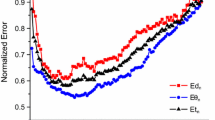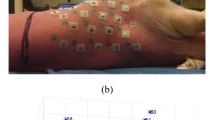Abstract
The aim of the present paper, is the estimation of the distance between an electrode used as a recording site of the extracellular potential field and a surviving myocardial bundle. The importance of the reliable solution of this problem lies among others in controlling ablation. For our purposes one-dimensional propagation is considered and current sources are activated along a cable simulating the propagating waves with constant velocity. Different models of current sources are explored. By use of these models, the corresponding functions expressing extracellular potentials are calculated, using the volume conductor equation. This way, extracellular potentials are modeled as parametric functions of longitudinal distance, while perpendicular distance, current source strength, and other factors related to the propagated wave are parameters of the functions. Simulated annealing is applied for model parameter estimation and appropriate Time Domain and Wavelet Domain cost functions are investigated. Different combinations of model and cost function are evaluated regarding the accuracy of distance estimation. A continuous source model function with a wavelet cost function was found to be the most accurate combination. The accuracy of distance estimation is related to the selected source model and to the actual distance of recording in a nonmonotonic way.
Similar content being viewed by others
REFERENCES
Akay, M. Wavelets in biomedical engineering. Ann. Biomed. Eng. 23:531-541, 1995.
Albers, B. A., J. H. Put, W. Wallinga, and P. Wirtz. Quantitative analysis of single muscle fibre action potentials recorded at known distances. Electroencephalogr. Clin. Neurophysiol. 73(3):245-253, 1989.
Barnard, E., and D. Casasent. Invariance and neural nets. IEEE Trans. Neural Netw. 2(5):498-508, 1991.
Bevington, P. R. Data Reduction and Error Analysis for the Physical Sciences. New York: McGraw-Hill Book, 1969.
Chouvarda, I., N. Maglaveras, F. J. L. Van Capelle, J. de Bakker, C. Pappas, and M. Strintzis. Comparison of time and frequency based methods for electrode distance estimation from surviving tissue. Comput. Cardiol. 24:331-334, 1997.
De Bakker, J. M. T., F. J. L. Van Capelle, M. J. Janse, S. Tasseron, J. T. Vermeulen, N. de Jonge, and J. R. Lahpor. Slow conduction in the infarcted human heart, “ZigZag” course of activation. Circulation 88:915-926, 1993.
Ellis, W. S., D. M. Auslander, and M. D. Lesh. Fractionated electrograms from a computer model of heterogeneously uncoupled anisotropic ventricular myocardium. Circulation 92(6):1619-1626, 1995.
Everett-Carter, Jr., F. Taygeta Scientific Inc. http://www.taygeta.com/annealing/simanneal.html.
Henriquez, C. S., and, A. A. Papazoglou. Using computer models to understand the roles of tissue structure and membrane dynamics in arrhythmogenesis. Proc. IEEE 37(3):334-354, 1996.
Henriquez, C. S., and R. Plonsey. Simulation of propagation along a cylindrical bundle of cardiac tissue-I: Mathematical formulation of simulation. IEEE Trans. Biomed. Eng. 37(9):850-860, 1990.
Henriquez, C. S., and R. Plonsey. Simulation of propagation along a cylindrical bundle of cardiac tissue-II: Results of simulation. IEEE Trans. Biomed. Eng. 37(9):861-875, 1990.
Henriquez, C. S., N. Trayanova, and R. Plonsey. Potential and current distributions in a cylindrical bundle of cardiac tissue. Biophys. J. 53(6):907-918, 1988.
Ingber, L. Simulated annealing:Practice versus theory. J. Math. Comp. Modell. 18(11):29-57, 1993.
Jain, A. K., P. W. Duin, and J. Mao. Statistical pattern recognition: A review. IEEE PAMI 22(1):4-37, 2000.
Kirkpatrick, S. Optimization by simulated annealing: Quantitative studies. J. Statist. Phys. 34:975-986, 1984.
Kirkpatrick, S., C. D. Gelatt Jr., and M. P. Vecchi. Optimization by simulated annealing. Science 220(4598):671-680, 1983.
Maglaveras, N., J. M. T. De Bakker, F. J. L. Van Capelle, C. Pappas, and M. Janse. Activation delay in bifurcating strands of surviving myocardial tissue in healed infarction. A comparison between model and experiment. Am. J. Phys. Heart Circ. Physiol. 269(38):H1441-H1449, 1995.
Maglaveras, N., F. Offner, F. J. van Capelle, M. A. Allessie, and A. V. Sahakian. Effects of barriers on propagation of action potentials in two-dimensional cardiac tissue. A computer simulation study. J. Electrocardiol. 28(1):17-31, 1995.
Maglaveras, N., F. J. L. Van Capelle, and J. DeBakker. Wave propagation simulation in normal and infarcted myocardium. Computational and modeling issues. Med. Inform. (Lond.) 23(2):105-118, 1998.
Mallat, S. A theory for multiresolution signal decomposition: The wavelet representation. IEEE Trans. PAMI 11(7):674-691, 1989.
Mallat, S. Singularity detection and processing using wavelets. IEEE Trans. Inf. Theory 38:617-643, 1992.
Morita, M. Associative memory with nonmonotonic dynamics. Neural Netw. 6:115-126, 1993.
Panfilov, A., and J. P. Keener. Generation of reentry in anisotropic myocardium. J. Cardiovasc. Electrophysiol. 4(4):412-421, 1993.
Parker, K. K., and J. P. Wikswo. A model of the magnetic fields created by single motor unit compound action potentials in sceletal muscle. IEEE Trans. Biomed. Eng. 44(10):948-957, 1997.
Plonsey, R., and R. C. Barr. Interstitial potentials and their change with depth into cardiac tissue. Biophys. J. 51:547-555, 1987.
Press, W. H., S. A. Teukolsky, W. T. Vetterling, and B. P. Flannery. Numerical Recipes in C: The Art of Scientific Computing, 2nd ed. Cambridge: Cambridge University Press, 1992.
Roberge, F. A., A. Vinet, and B. Victorri. Reconstruction of propagated electrical activity with a two-dimensional model of anisotropic heart muscle. Circ. Res. 58(4):461-475, 1986.
Spach, M. S., and P. Dolber. Relating extracellular potentials and their derivatives to anisotropic propagation at a microscopic. Circ. Res. 58:356-371, 1986.
Spach, M. S., J. F. Heidlage, E. R. Heidlage, E. Hofer, K. H. Raines, and C. F. Starmer. Cellular V′max reflects both membrane properties and the load presented by adjoining cells. Am. J. Physiol. 263:H1855, 1992.
Sykulski, J. K., M. Rotaru, M. Sabene, and M. Santilli. Comparison of optimization techniques for electromagnetic applications. COMPEL 17(1–3):171-176, 1998.
Trayanova, N. A method for calculation the extracellular poten-tials from experimentally recorded intracellular potentials of a single muscle fibers. Acta Physiol. Pharmacol. Bulg. 14(2):83-91, 1988.
Trayanova, N. A., C. S. Henriquez, and R. Plonsey. Limitations of approximate solutions for computing the extracellular potential of single fibers and bundle equivalents. IEEE Trans. Biomed. Eng. 37(1):22-35, 1990.
Xie, B., S. C. Heald, A. J. Camm, E. Rowland, and D. E. Ward. Successful radiofrequency ablation of accessory pathways with the first energy delivery: The anatomic and electrical characteristics. Eur. Heart J. 17(7):1072-1079, 1996.
Author information
Authors and Affiliations
Rights and permissions
About this article
Cite this article
Chouvarda, I., Maglaveras, N., Pappas, C. et al. Estimation of Distance Between a Unipolar Recording Electrode and a Myocardial Bundle Based on Signal Characteristics. Annals of Biomedical Engineering 32, 1336–1347 (2004). https://doi.org/10.1114/B:ABME.0000042222.90548.00
Issue Date:
DOI: https://doi.org/10.1114/B:ABME.0000042222.90548.00




